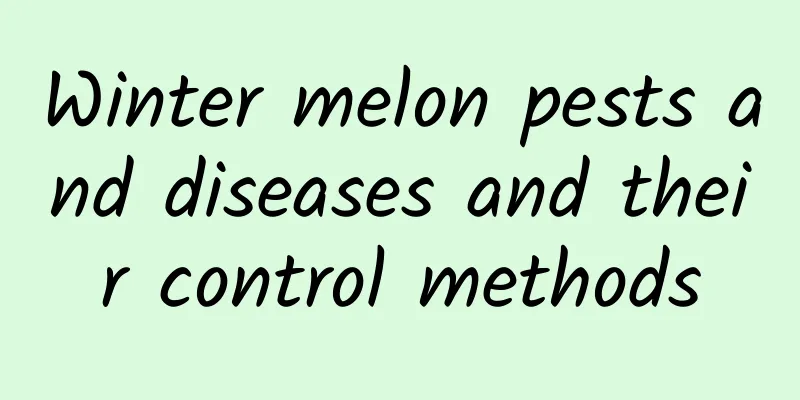Winter melon pests and diseases and their control methods

|
Many vegetables will encounter various diseases during the planting process, and winter melon is no exception. Today I will tell you about the diseases of winter melon: Winter melon overviewThe common pests and diseases that harm winter melon are the same as those of bitter melon, and another common disease is wilt. Winter melon wilt is a devastating soil-borne disease. Its pathogens can survive in the soil and uncomposted organic bases for 5 to 7 years, and seeds can also carry bacteria. Comprehensive control measures should be adopted to prevent and control wilt: (1) Plant disease-resistant varieties, such as black-skinned winter melon (2) Seed disinfection: Soak the seeds in water, wait for them to absorb water (do not germinate), drain, take 1 pack (10 ml) of 2.5% Celex suspension, add 150-200 ml of water, pour the seeds and the solution into a container and mix thoroughly (1 pack of Celex can be used to mix 5-10 kg of seeds), and then germinate. The seeds treated with Celex will germinate neatly and vigorously, and can also cure other diseases in the seedling stage. (3) Seedling cultivation: The soil for the nutrient cup or seedling bed should be new mud or pond mud. If it is taken from Honda, the soil must be disinfected: add 2-3 liang of agricultural formalin to 50 jin of water for every 100 jin of soil, wet and mix well, cover and seal with plastic film for 5-7 days, then remove the film, flatten and dry in the sun for 7-14 days to allow the residual formalin to fully evaporate before sowing; Medicinal soil spreading method: mix 1 jin of medicine (50% thiram wettable powder or 50% carbendazim wettable powder) per load of soil to make medicinal soil; spray the bed soil with 50% carbendazim wettable powder, or 75% dichlorvos original powder, 64% alum wettable powder 500 times diluted, and the dosage per square meter of bed soil is 25-30 grams. (4) Choose a plot with high terrain and good drainage and irrigation, and plant in high ridges and deep trenches (5) Two days before transplanting, sprinkle the soil in the nutrient cup with 2000 times diluted 2.5% Cialis suspension. When transplanting, use the same concentration of Cialis solution as rooting water, half a pound of solution per plant. Sprinkle once every 10 to 15 days for 2 to 3 times in a row. You can also use it alternately with 500 times diluted 50% carbendazim wettable powder and 500-800 times diluted 75% dichlorodiphenyltrichloroethane original powder. (6) Clean the fields: Remove diseased plants promptly, remove them from the field and burn them. After harvesting the vines, pile them together for fermentation or burn them together to reduce pathogens in the field. Winter melon blight【Disease characteristics】: This disease mainly harms winter melon fruits. The diseased part of the infected fruit is water-soaked, and a circle of white mold appears at the junction of the diseased and healthy parts. When the diseased fruit is cut open, it can be seen that the flesh under the skin of the diseased part is also brown. In severe cases, the fruit will rot. [Pathogenesis]: The pathogen survives the winter in the form of mycelium and oospores left in the soil with diseased remains, and relies on rainwater to spread and infect. Warm and humid weather is conducive to the disease, and continuous cropping and low humidity are also prone to the disease. 【Prevention and treatment methods】: (1) Select and breed disease-resistant varieties. (2) After germination and during the fruit expansion period, spray pesticides regularly or irregularly to prevent and control diseases. (3) Spray with 600 times diluted 70% Kangbo or 400 times diluted 70% ethylene phosphine aluminum manganese zinc. Winter melon charcoal rot【Disease characteristics】: Mainly harms fruits. Infected fruits develop large purple-black to dark brown spots, which are round to irregular in shape. In severe cases, the affected part endangers most of the fruit, which becomes soft and wrinkled. A closer look reveals that the spots are densely covered with needle-sized black particles, and the flesh under the skin also turns brown and rots. After losing water, it looks like black charcoal, hence the name charcoal rot. This disease can continue to cause harm during the post-harvest storage period. [Pathogenesis]: The pathogen survives the winter in the soil with mycelium and asexual fruiting body conidiophores along with diseased remains, using endogenous conidia as the primary and secondary inoculum, spreading and infecting with the help of rain splashing. Warm and humid weather or planting environment are conducive to the disease, and continuous cropping land and low-lying wetlands are prone to induce the disease. 【Prevention and treatment methods】: (1) Select disease-resistant varieties. (2) If diseases such as blight, anthracnose and powdery mildew are effectively controlled, this disease can basically be controlled as well, and there is no need to control it separately. (3) During the storage period, cleaning and disinfection of the cellar before storage and paying attention to regulating temperature and humidity can reduce the occurrence of this disease during storage. |
<<: Winter melon cultivation points, practical winter melon planting techniques
>>: Nutritional components and health-care effects of wax gourd
Recommend
Can drinking vinegar help you get rid of alcohol? Can drinking vinegar help you lose weight?
Many people know that drinking vinegar can help y...
The benefits of corn oatmeal
I believe everyone wants to know the benefits of ...
What are the benefits of drinking pure mountain wine?
The mountain wine made from wild grapes is not on...
How is Buccellati? Buccellati reviews and website information
What is Buccellati? Buccellati is a legendary Ital...
How to make fried sea cucumber with green onion
Sea cucumber, a precious ingredient, has become m...
The benefits of eating grapefruit peel candy
Grapefruit peel candy is a popular snack food in ...
How is RSA Insurance Group? RSA Insurance Group reviews and website information
What is the website of RSA Insurance Group? RSA In...
What are the benefits of eating hazelnuts for women
As we all know, hazelnut is a highly nutritious n...
How is Franke? Reviews and website information
Franke_What is Franke's website? Franke is a f...
How is AECOM? AECOM company reviews and website information
What is the website of AECOM? AECOM is a world-ren...
What are the benefits of drinking apple papaya juice?
In daily life, people not only like to eat apples...
How to grow bitter melon Bitter melon planting methods and tips
Bitter melon is a very common vegetable with a bi...
The harm of eating chicken essence to the body
There are endless condiments on the market now, a...
Turkmenistan Airlines Reviews and Website Information
What is the website of Turkmenistan Airlines? Turk...
What are the benefits of African jasmine to people? How to propagate African jasmine
African jasmine is a beautiful ornamental plant. ...









